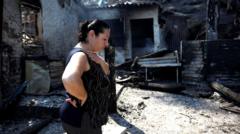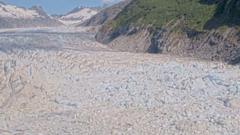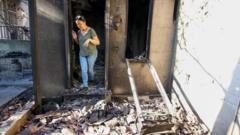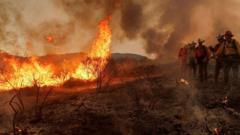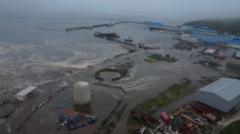The wildfire season in Canada has escalated dramatically, leading to evacuations, emergency measures, and intense firefighting efforts across the nation.
**Canada Faces Devastating Wildfire Season: Community Evacuations Intensify**

**Canada Faces Devastating Wildfire Season: Community Evacuations Intensify**
Thousands forced to evacuate as wildfires sweep through Eastern Canada amid dangerous fire conditions.
Despite alleviating rainfall in parts of Western Canada, the threat of wildfires crystalizes in Eastern regions, prompting state of emergency measures and serious concerns for the health and safety of many communities.
Mandatory evacuation orders have affected numerous towns in Newfoundland and Labrador, as wildfires rage uncontrollably throughout Eastern Canada, marking this season as one of the worst in Canada's history. Approximately 700 fires are currently active, a reflection of the alarming fire dynamics established due to prolonged periods of drought and extreme heat.
Since January, an expansive area of 18.5 million acres has burned, nearly rivaling the catastrophic statistics of 2023, which saw 31.3 million acres burned during the summer months alone. Awa Cissé, a spokesperson from the Canadian Interagency Forest Fire Center, warns that despite fewer acres being consumed than last year, the fire season stretches into months beyond current assessments.
The summer of 2025 has posed unprecedented challenges due to weather extremes; parched landscapes and low snowpack hold significant culpability in this year’s fire outbreaks. Saskatchewan and Manitoba are witnessing especially fierce wildfires, with the Shoe fire in Saskatchewan covering an area surpassing the size of the Grand Canyon.
However, recent rain in Western regions has provided some reprieve. Experts suggest that this change in weather may help mitigate the growth of existing fires and decrease the possibility of igniting new blazes, as noted by Environment Canada’s meteorologist, Brian Proctor.
In stark contrast, Newfoundland and Labrador currently endure atypical wildfire scenarios, with several blazes classified as out of control in a region traditionally less impacted by such events. Research scientist Yan Boulanger highlights the critical situation in St. John’s and surrounding areas, which are now facing dry conditions that are rarely seen outside of Western Canada.
As the situation unfolds, authorities have declared states of emergency in affected regions and instituted strict fire bans, including restrictions on the usage of off-road vehicles on combustible lands, despite no direct findings linking the vehicles to the fires. Premier John Hogan affirmed that violations will result in penalties, urging residents to prioritize safety amid ongoing threats from wildfires.
Outside of these alarming developments, Quebec has largely escaped severe wildfire damage this season, owing to beneficial wet weather during the spring and early summer months. As communities brace for further developments, the focus remains on effective firefighting strategies and safeguarding public health.
Mandatory evacuation orders have affected numerous towns in Newfoundland and Labrador, as wildfires rage uncontrollably throughout Eastern Canada, marking this season as one of the worst in Canada's history. Approximately 700 fires are currently active, a reflection of the alarming fire dynamics established due to prolonged periods of drought and extreme heat.
Since January, an expansive area of 18.5 million acres has burned, nearly rivaling the catastrophic statistics of 2023, which saw 31.3 million acres burned during the summer months alone. Awa Cissé, a spokesperson from the Canadian Interagency Forest Fire Center, warns that despite fewer acres being consumed than last year, the fire season stretches into months beyond current assessments.
The summer of 2025 has posed unprecedented challenges due to weather extremes; parched landscapes and low snowpack hold significant culpability in this year’s fire outbreaks. Saskatchewan and Manitoba are witnessing especially fierce wildfires, with the Shoe fire in Saskatchewan covering an area surpassing the size of the Grand Canyon.
However, recent rain in Western regions has provided some reprieve. Experts suggest that this change in weather may help mitigate the growth of existing fires and decrease the possibility of igniting new blazes, as noted by Environment Canada’s meteorologist, Brian Proctor.
In stark contrast, Newfoundland and Labrador currently endure atypical wildfire scenarios, with several blazes classified as out of control in a region traditionally less impacted by such events. Research scientist Yan Boulanger highlights the critical situation in St. John’s and surrounding areas, which are now facing dry conditions that are rarely seen outside of Western Canada.
As the situation unfolds, authorities have declared states of emergency in affected regions and instituted strict fire bans, including restrictions on the usage of off-road vehicles on combustible lands, despite no direct findings linking the vehicles to the fires. Premier John Hogan affirmed that violations will result in penalties, urging residents to prioritize safety amid ongoing threats from wildfires.
Outside of these alarming developments, Quebec has largely escaped severe wildfire damage this season, owing to beneficial wet weather during the spring and early summer months. As communities brace for further developments, the focus remains on effective firefighting strategies and safeguarding public health.


